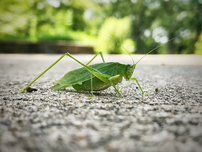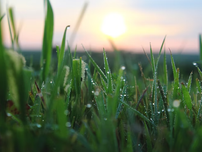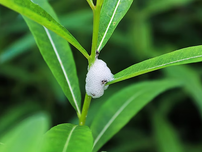top of page
All Posts


Get crafting: Make your own paper python
Meet Penny, a curious ball python at Plum Creek Nature Center! Kids can make their own spiral snake craft inspired by her using paper, scissors, and decorations. Penny is a constrictor with shiny, copper-colored scales and uses her tongue to smell. This fun activity teaches colors and patterns, mimicking real snake markings. Add a forked tongue and hang your creation! Learn more with a one-hour Nature Play Day video all about snakes.


The sounds of summer: How do insects sing?
Insects from the order Orthoptera, such as crickets, katydids, and grasshoppers, rub two body parts together to produce sound in a process called stridulation. Insects communicate through song to attract mates, to give directions, to claim territories, or to signal danger. Hairs located on their bodies can pick up sounds and help determine where they are coming from. Some insects use vibrations felt in their leg joints to hear. Others have tympanal organs that process vibrati


Heard but not seen: Coyotes thrive in the dark
Coyotes are smart and adaptable predators found across Illinois, even in cities. They look like medium-sized dogs with yellow eyes and black-tipped tails. Mates raise pups in underground dens. Coyotes eat almost anything including rodents, berries, and carrion. They are nocturnal and often howl at night. They communicate using sound, smell, and body language. Coyotes help maintain healthy ecosystems by controlling prey populations.


Myth buster: Opossums don't hang by their tails
Opossums cannot hang by their tails for long because their tails are not strong enough to support their weight. They use them to climb and balance but not for sleeping upside down. One real but rare behavior is playing dead. When threatened some opossums enter a catatonic state and appear lifeless to avoid predators. This usually happens in younger animals while most prefer to run away when scared.


Wet grass in the morning might be from dew not rain
Dew is moisture that forms because of condensation, when water vapor turns into water. Whether dew forms depend on how cloudy the sky was the night before. Dew is most likely in the morning following a warm, sunny day that led into a cooler night with clear skies. Dew point is the temperature at which dew will form and varies depending on factors like air temperature, time of day and location. The dew point is the temperature air needs to be cooled to for the humidity to be 1


Young dragonflies look nothing like adult versions
As eggs, larva and nymphs (also known as naiads), young dragonflies live underwater up until adulthood when their metamorphosis process is complete. Nymphs grow by molting and can take several years until becoming full grown adults. They breathe through their gills and use jet propulsion to move within the water. They are fierce water hunters and will eat anything they catch with the help of their powerful, fast, and hook-like lower jaw.


Learn the science of shadows while having fun
Shadows form when light hits an object and is blocked, creating darkness behind it. Shadows can be useful, like shade on a hot day and telling time and direction as they shift with the sun. You can trace shadows to watch them change or play games like shadow tag. For some fun, be creative and try making hand shadows or puppets. Shadows let us explore light and movement.


Is that spit on that plant? Nope, just a spittlebug
Spittlebugs are baby froghoppers that create frothy bubbles on plants to hide from predators. They feed on plant nutrients and produce spit-like foam as a byproduct. Inside the bubbles, you can find green or yellow nymphs with red eyes. As they grow, they shed their skin and become adult froghoppers that can leap impressively high for their size. These insects are harmless to plants and easy to spot in gardens and prairies.


How old is that tree? Learn how to tell with simple math
Scientists who study dendrochronology use a special tool called an increment borer to cut out a thin chunk of a tree to count its number of rings to determine the tree’s age. Tree rings grow in relation to the weather, so a lot can be told about past climate conditions. You can use math to get a close estimate of a tree’s age by measuring the tree’s circumference to find its diameter. You can then multiply the diameter by the tree’s growth factor based off its species type.


Can you ID the frog? Bullfrog vs. green frog
Bullfrogs and green frogs can both be found in our ponds and look very similar to one another. Key differences include size, ridges, and their songs. Bullfrogs are bigger in size, growing up to 6 inches long, have ridges, formally known as dorsolateral folds, that wrap around their ears, and males have a deep pitched song. Green frogs are smaller, growing up to 3 ½ inches long, have ridges that go from the back of their head down to their legs, and males have a single note so


It's OK to handle a baby bird, but many don't need help
The common myth that mothers will abandon their baby birds or eggs after being touched by a human is not true. Given their poor sense of smell, mothers cannot smell a human’s touch. If a nestling is found on the ground, gently pick it up and place it in its nest. If a fledgling is found on the ground, no human intervention is needed. If you are ever unsure of what to do, ask your parents for help or ask them to contact a local wildlife rehabilitation center.


Birds can really belt out a tune. Learn how they do it
Birds have a special voice box called a syrinx, allowing them to sing two notes at once. Some, like wood thrushes and northern cardinals, create complex songs. Mimics like mockingbirds, catbirds and blue jays can copy other birds and even animals. The superb lyrebird can even imitate man-made sounds like chainsaws. Try listening to bird songs, recording them or singing along to discover the amazing voices of birds around you.


Illinois' monster: a creature from the past
The Tully monster, a bizarre sea creature from 300 million years ago, once swam in Illinois’ swampy estuaries. It had a tube-shaped body, stalked eyes, and a trunk-like snout with a toothy claw at the end. Scientists still debate if this monster is a vertebrate or an invertebrate. Discovered in the 1950s by Francis Tully near Braidwood, this mysterious fossil puzzled experts and earned the nickname "Tully monster." It’s now Illinois’ official state fossil.


These little stinkers give plenty of warnings
A striped skunk’s family name, Mephitidae, literally means stink. It takes a lot of energy to produce their spray, taking up to 10 days to load back up. This is why skunks deploy multiple warning signs before deciding to spray. Warning signs include making their stripes that lead to their spray gland visible, raising and wagging its tail, stomping its front feet on the ground while lifting its hind legs, and lastly, making a “U” shape with its body to take aim.


If you use moss as a compass, you may get lost
The idea that moss only grows on the north side of trees is a myth. While moss often grows on the shadier north side in the northern hemisphere, it can grow in any direction where conditions are moist and shady. Mosses are nonvascular plants that absorb water from their environment, not through roots. They often grow on tree bark because it provides a good growing surface and little competition. Moss does not harm trees.


Tiny spring peepers create the sounds of spring
The spring peeper frog, Pseudacris crucifer, is named after its high-pitched call that marks the start of their mating season early in the spring after spending the winter months frozen under piles of leaves, healthily waiting for warmer weather. A male’s high-pitched sound is made possible by their inflatable, stretchy vocal sac. Despite finding them near or along bodies of water, spring peepers are tiny woodland frogs that are active during the night.


Illinois' state symbols include wildlife we love
Illinois has many state symbols, most chosen by schoolchildren. The violet is the state flower, and the white oak is the state tree. The northern cardinal is the state bird. The monarch butterfly, which relies on milkweed, is the state insect. Other symbols include the white-tailed deer (state animal), bluegill (state fish), eastern tiger salamander (state amphibian), and the painted turtle (state reptile) - all representing Illinois' rich wildlife.


No, touching a frog won't give you warts
Touching frogs or toads won’t give you warts - that’s a myth. Warts are caused when human papillomavirus enters the body through a cut or scrape, not animals. Most viruses that cause warts are specific to a particular species. The bumps on frogs and toads are glands, not warts. While you can’t catch warts from them, some amphibians secrete toxins or carry bacteria that can irritate skin or make you sick. Always handle them gently with clean hands and wash thoroughly afterward


Catching snowflakes is a childhood rite of passage
Head outside to catch snowflakes for fun and for science! Try catching them on your tongue or use frozen black construction paper to observe their shapes. Use a magnifying glass for a closer look and keep a journal of what you have observed. Are the flakes big or small? Falling fast, slow or at an angle? Snow is not just fun - it’s a great way to explore nature too!


Why do animals have fur?
Fur, a collection of individual hairs that covers an animal’s skin, is one of the adaptations that sorts an animal into the mammal group. Fur is made up of keratin and contains multiple layers (down hairs and guard hairs) that can trap heat, create a water-resistant surface, protect skin from UV rays, and can help camouflage animals to their habitats. Other specialized hairs include whiskers, quills, and bristles. Fur is crucial to an animal's survival.
bottom of page